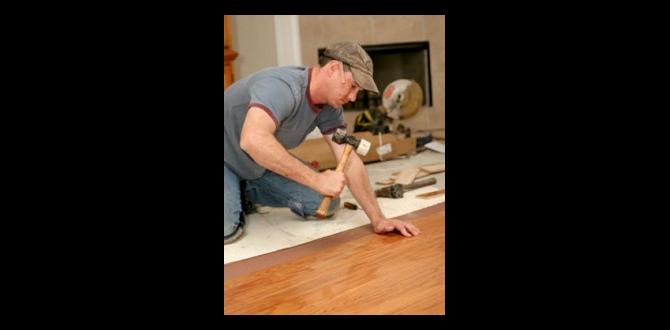Wondering if your nail gun needs a check-up? Look for common issues like weak drives, jams, leaks, or strange noises. Regular servicing keeps your tool reliable and safe for every project.
Hey there, fellow DIYers and woodworkers! Jack Shaffer here from Nailerguy. We all love our trusty nail guns. They make projects go from tough to doable, right? But sometimes, our favorite tools can start acting a little… well, stubborn. You might notice your nail gun isn’t performing like it used to, feeling sluggish, or even jamming up more than a beginner at a wood joint. Don’t worry! Recognizing the signs your nail gun needs servicing is key to keeping it in top shape. This isn’t about being a master mechanic; it’s about knowing your tool and giving it what it needs to keep on firing nails smoothly. Let’s dive into what to look for so you can tackle your next project with confidence!
Table of Contents
Why Servicing Your Nail Gun Matters
Think of your nail gun like your trusty sidekick on countless projects. Keeping it well-maintained isn’t just about avoiding frustration; it’s about ensuring safety, longevity, and efficiency. A nail gun that’s working perfectly drives nails straight and deep, making your connections solid and your work look professional. When it’s not right, you risk weak joints, wasted materials, and, importantly, potential injury. Regular check-ups and simple maintenance can prevent small problems from becoming big, costly repairs. Plus, who wants to be in the middle of a project and have their nailer quit on them?
Common Signs Your Nail Gun Needs Servicing
Our tools talk to us, in a way. We just need to learn their language! Here are some of the most common signals your nail gun is sending when it’s time for a little TLC:
1. Weak Nail Drives or Inconsistent Depth
This is a big one. You fire the nail gun, and instead of sinking flush, the nail sticks out awkwardly. Or sometimes it goes in perfectly, and the next one barely pierces the wood. This inconsistency can be super frustrating. It might mean your nail gun is losing air pressure, the driving force isn’t as strong as it used to be, or there’s an obstruction interfering with the piston.
What to look for:
Nails not sinking fully into the material.
Nails sinking too deep, creating a dimple.
Inconsistent nail depth from shot to shot.
The “thud” of the drive sounds weaker than usual.
2. Frequent Nail Jams
We all deal with a jam now and then, it’s part of the nail gun life! But if you’re finding yourself clearing jams after almost every few nails, something’s likely not right. This could be due to a bent or worn driver blade, a misaligned magazine, or even debris getting into the mechanism.
When to be concerned:
Jams happening more often than usual.
Nails bending or breaking as they feed.
Difficulty unjamming the tool; nails seem stuck fast.
3. Air Leaks or Hissing Sounds
Pay attention to what you hear and feel. If you notice air constantly escaping from the tool, even when you’re not firing, that’s a tell-tale sign. Leaks often come from worn O-rings, seals, or gaskets. Not only does this waste air, but it can also reduce the power of your nail gun and make it less efficient.
Symptoms of air leaks:
A continuous hissing sound when the tool is idle.
Feeling air pushed out around hose connections or trigger area.
The nail gun cycling or recoiling even when not actively pressing the trigger.
4. Trigger Malfunctions or Stickiness
The trigger is your command center. If it feels sticky, hard to pull, or doesn’t reset properly, it’s a significant cause for concern. This could be due to dirt and grime buildup, a damaged trigger spring, or issues with the safety mechanism. A sticky trigger can be more than annoying; it can be a safety hazard.
Trouble signs:
Trigger is difficult to pull.
Trigger doesn’t return smoothly after firing.
The safety tip of the nail gun (the part you press against the wood) seems stuck or unresponsive.
5. Unusual Noises
Listen to your tool. Does it sound different? Grinding, squeaking, or clanking sounds that weren’t there before can indicate internal problems. These noises often mean something is worn out, rubbing against something it shouldn’t be, or has come loose inside.
Listen for:
Grinding or scraping sounds during operation.
Squeaking that sounds like metal on metal.
Loud banging or rattling that isn’t the normal recoil.
6. Overheating or Excessive Vibration
If your nail gun feels significantly warmer than usual even after short bursts of use, or if the vibrations are much more intense than normal, it’s a warning sign. This can point to internal friction, problems with lubrication, or components that are starting to wear down unacceptably.
What to notice:
The tool housing getting unusually hot quickly.
Excessive and uncomfortable shaking or vibration when firing.
7. Dented or Damaged Magazine
The magazine is where the nails are stored and fed. If it’s visibly dented, bent, or damaged, it can interfere with the smooth feeding of nails. This will inevitably lead to jams and misfires. A damaged magazine might need to be replaced or carefully realigned.
Inspect the magazine for:
Cracks or deep dents.
Bent tracks that guide the nails.
The follower or spring mechanism getting stuck.
Troubleshooting Common Issues: A Beginner’s Guide
Before you decide your nail gun needs a full overhaul, there are a few simple things you can check and try yourself. Often, these quick fixes solve the problem!
1. Check Your Air Supply
This is the easiest one to fix! For pneumatic (air-powered) nail guns, ensure your air compressor is set to the correct PSI (pounds per square inch) recommended by your nail gun manufacturer. Too little air means weak drives, too much can damage the tool. Also, check your air hose for kinks or leaks.
Steps:
1. Refer to your nail gun’s manual for the recommended PSI range.
2. Adjust your compressor’s regulator accordingly.
3. Ensure the air hose is properly connected and free of visible damage.
4. Briefly disconnect the hose at the nail gun end to ensure good airflow.
2. Clean and Lubricate
Dirt and lack of lubrication are the banes of many tools. Most nail guns have a simple maintenance routine that involves cleaning the nose, magazine, and lubricating the piston area.
Simple Cleaning & Lube Steps (Pneumatic):
1. Disconnect the air supply! Safety first, always.
2. Remove any loaded nails from the magazine.
3. Use a clean cloth to wipe down the exterior of the nail gun, focusing on the nose and magazine.
4. For many pneumatic guns, you’ll need to remove a few screws (check your manual!) to access the cylinder.
5. Wipe away any old, gunked-up oil or dust from the piston and cylinder.
6. Apply a few drops of recommended pneumatic tool oil (check your manual for specifics – usually a light, non-detergent oil) into the air inlet port or directly onto the piston if accessible.
7. Reconnect the air supply and fire a few test nails into scrap wood.
For battery-powered and listrik nail guns, the maintenance is usually less about lubrication and more about keeping the driving mechanism clean and free of debris.
3. Inspect the Driver Blade
The driver blade is the part that actually pushes the nail. If it’s bent, worn, or chipped, it can cause jams and incomplete drives.
How to inspect:
1. Disconnect the air supply or battery.
2. Carefully access the driver blade area (refer to your manual).
3. Look for any visible damage, bends, or excessive wear on the tip or shaft.
4. If it looks damaged, it likely needs replacement. This is often a job for a professional if you’re unsure.
4. Ensure Magazine Alignment
If nails are feeding poorly or jamming at the point of exit from the magazine, the magazine might be out of alignment or the feed mechanism could be obstructed.
What to check:
1. Visually inspect the magazine for any dents or bends that might be pinching the nails.
2. Check that the nails are sitting straight in the magazine and not at an angle.
3. Carefully slide the magazine open (if applicable) or check the internal feed components for any debris.
When to Call in the Pros or Consider Replacement
While many small issues can be fixed with basic cleaning and a bit of oil, some signs point to more serious problems that might be beyond a beginner’s quick fix.
Internal Component Damage: If you hear significant grinding, or if major parts seem loose or damaged internally, do not try to force it. Internal repairs can be complex and may require specialized tools.
Safety Mechanism Failure: If the safety contact tip or trigger mechanism isn’t working reliably, it’s a critical safety issue. Don’t use the tool until it’s repaired by a qualified technician.
Persistent Problems: If you’ve tried the basic troubleshooting steps and the issues persist, it’s time to seek professional help or consider if the cost of repair outweighs buying a new tool, especially for older or heavily used nailers.
Cracked Housing: A cracked or significantly damaged main body of the nail gun compromises its structural integrity and is a safety concern.
Understanding Different Nailer Types and Their Servicing Needs
While the core principles of maintenance apply broadly, there are slight differences depending on your nail gun’s power source.
Pneumatic Nail Guns
These are the most traditional and robust. They run off compressed air from an external compressor.
Key Servicing Points:
Lubrication: Regular oiling via the air inlet is crucial for the piston and seals.
Air Filter: If your compressor has an air filter, ensure it’s clean to prevent debris from entering the tool.
O-rings and Seals: These are the most common wear items and will need replacement over time due to air leaks.
Driver Blade: This takes the brunt of the work and will eventually need sharpening or replacement.
Electric Nail Guns (Corded & Cordless)
These use an electric motor to drive a mechanism, either a spring-loaded driver or a compressed air/gas system powered by the battery.
Key Servicing Points:
Battery Health: For cordless models, ensuring your batteries are in good condition is key to consistent power.
Motor Compartment: Keep the motor vents clear of dust and debris.
Driving Mechanism: Cleanliness here is essential to prevent jamming. Lubrication needs are often minimal and specific to the model.
Safety Features: Ensure any safety tips or contact elements are clean and functional.
External Resource: To understand air pressure requirements and safety standards for pneumatic tools, the Occupational Safety and Health Administration (OSHA) provides valuable guidelines. You can often find relevant information on their website, such as their Powertools Safety page, which covers nail gun safety.
Fuel Cell / Pneumatic Hybrid Nailers
These often combine a battery and a fuel cell to create a small explosion, driving the nail.
Key Servicing Points:
Fuel Cell Inlet: Keep this clean and free of debris.
Battery: Similar to cordless electrics, battery health is important.
Spark Plug: In some models, the spark plug may need occasional cleaning or replacement.
Internal Cleanliness: Debris can affect the driving combustion.
Service Interval Guide: Best Practices
To give you a smoother workflow, here’s a general idea of when you might want to perform certain maintenance tasks. Always refer to your specific tool’s manual for exact recommendations!
| Maintenance Task | Frequency (Typical Use) | Notes |
|---|---|---|
| Wipe Down/Exterior Cleaning | After each use | Removes dust and debris; prevents buildup. |
| Lubricate Pneumatic Tool | Daily or every 10-15 hours of use | Use specific pneumatic tool oil; check manual. |
| Check Driver Blade | Monthly or as needed if issues arise | Look for wear, bends, or chips. Replacement may be necessary. |
| Inspect O-rings & Seals (Pneumatic) | Every 6-12 months, or if leaks are present | Listen for air leaks; replace worn seals to prevent leaks. |
| Clean Magazine and Feed Mechanism | Monthly or if experiencing feed issues | Ensure clear, unobstructed path for nails. |
| Full Internal Cleaning/Service | Annually or as recommended by manufacturer | May involve disassembly and professional attention for complex tools. |
Common Nailer Servicing FAQs
Got more questions? You’re not alone! Here are some common ones beginners often ask.
Q1: How often should I lubricate my pneumatic nail gun?
For most pneumatic nail guns, it’s best to lubricate them with a few drops of dedicated pneumatic tool oil in the air inlet port daily, or after about 10-15 hours of continuous use. This keeps the internal parts moving smoothly and prevents premature wear.
Q2: My nail gun is jamming a lot. What’s the first thing I should check?
The very first thing to check is your nails! Make sure you’re using the correct size and type of nails specified for your nail gun. Also, ensure the nails are loaded straight into the magazine and aren’t bent or damaged before they even enter the tool. If the nails are good, then check for debris in the magazine or a bent driver blade.
Q3: Can I use any kind of oil to lubricate my nail gun?
No, it’s important to use oil specifically designed for pneumatic tools. These oils are usually light, non-detergent, and formulated to work with rubber seals and metal components without causing damage. Using regular motor oil or WD-40 can actually harm your nail gun over time.
Q4: What should I do if my nail gun starts making a grinding noise?
A grinding noise is a serious sign. First, disconnect the air or battery immediately. This indicates internal metal-on-metal contact, likely due to a worn-out part like the driver blade, piston, or cylinder. It’s best to stop using the tool and consult your manual or a professional repair service. Continuing to use it could cause more significant damage.
Q5: How do I know if I can fix it myself or if I need a professional?
Basic cleaning, lubrication, and visual inspection of easily accessible parts like the magazine are usually DIY tasks. If the issue involves disassembling the main body of the tool, dealing with complex internal mechanisms, or if you’re uncomfortable with the process, it’s safer and often more effective to take it to a qualified tool repair shop.
Q6: I see air leaking from the trigger. Is that normal?
A small puff of air when you initially connect the air line to a pneumatic tool might be normal on some models, but continuous hissing or leaking from the trigger area when the tool is idle or when you’re not firing is not normal. This usually indicates a problem with the trigger valve or associated seals, which means it’s time for servicing.
Q7: How important is it to use the correct nail collation angle?
Extremely important! Nail guns are designed for specific collation angles (the degree at which the nails are held together). Using the wrong angle can lead to jamming, damaged nails, and even damage to the nail gun itself, as the nails won’t feed correctly into the driver mechanism. Always match the nail collation angle to your tool’s specification.
Conclusion: Keep Your Nail Gun Firing Strong
Your nail gun is a valuable tool that can make your DIY projects so much more enjoyable and efficient. By staying attuned to the subtle (and not-so-subtle) signs that your tool might need a little attention, you can catch potential problems early. Regular cleaning, proper lubrication, and being mindful of unusual sounds or performance issues will go a long way in ensuring your nail gun serves you reliably for years to come. Don’t let a neglected tool hold back your creativity! A little proactive maintenance means more successful projects and less time spent troubleshooting. So, give your nail gun some love, and it will surely keep on delivering those satisfying “thwacks” project




